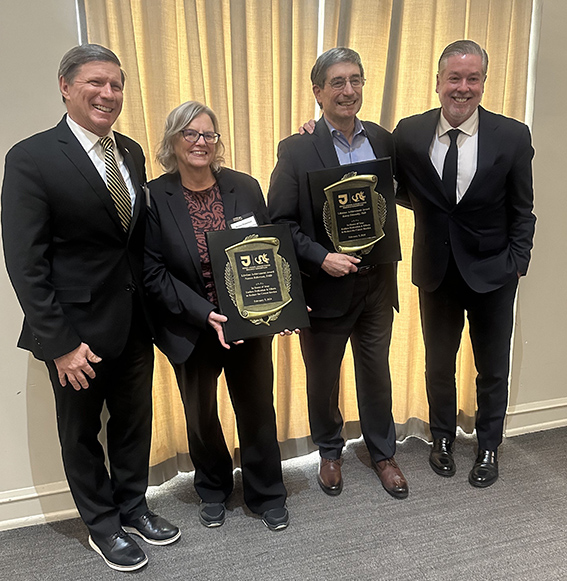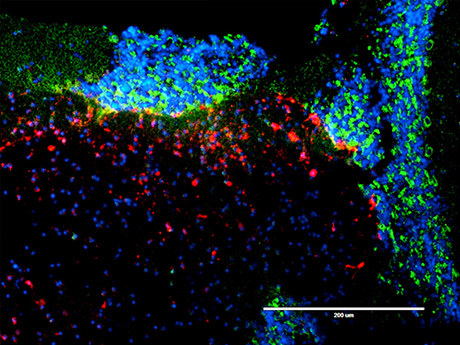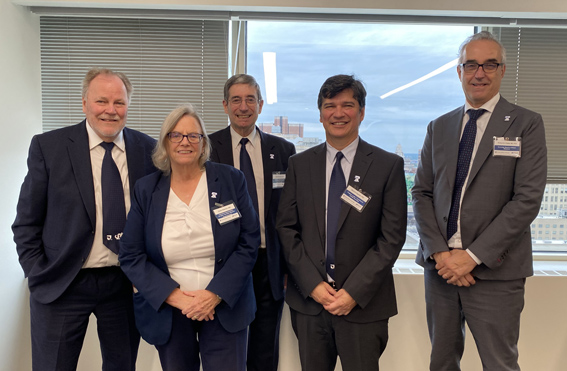Sidney Kimmel Cancer Center Research Consortium: Committed to Changing the Cancer Landscape in Philadelphia
Drexel University and Thomas Jefferson University are longtime allies in the fight against cancer. That partnership was formalized in 2013 as the Sidney Kimmel Cancer Center (SKCC) Research Consortium, a relationship that was reinvigorated in 2021, in preparation for the center’s application to be named a National Cancer Institute-designated comprehensive cancer center.

Dean Charles B. Cairns, MD, (left) and President John Fry (right) were present to honor Noreen Robertson, DMD, and Kenny Simansky, PhD, with Lifetime Achievement Awards at the SKCC Research Consortium retreat in February.
The SKCC, which is already an NCI-designated cancer center, has proved a powerful driver for resource allocation, research collaboration and community outreach over the past 10 years. It was in recognition of their achievements across those fronts that the SKCC applied for comprehensive status with the NCI when they renewed their consortium grant. A site visit was held in August 2023 and the review process is now underway, with an announcement expected in the spring.
The comprehensive designation would be a mark of prestige that promises to attract new opportunities when it comes to funding, faculty and collaboration, underscoring the level of quality the SKCC has maintained for years. Kenny J. Simansky, PhD, serves as senior vice dean for research at Drexel University College of Medicine, where he oversees the consortium partnership with Noreen Robertson, DMD, senior associate vice dean for research.
“There aren’t all that many cancer centers in the United States that are NCI-designated. It’s an important status symbol that reflects quality, because you have to earn that,” Simansky says.
The SKCC honored both Robertson and Simansky with Lifetime Achievement Awards in February in recognition of their longtime dedication to the consortium and to reducing the burdens of cancer, a mission that involves a growing network of partners.
Under a new agreement, the consortium with the SKCC now explicitly involves seven Drexel schools — a way of saying, in Simansky’s words, “If we’re going to be transformational as a consortium, then we need to take advantage of all the less typical things at the consortium that Drexel has to offer,” from insight into aging and caregiving in cancer from the College of Nursing and Health Professions to population science data analysis from the Dornsife School of Public Health.
“There’s lots of educational and intellectual endeavors that people can participate in across the consortium,” Robertson notes.
“Harnessing the depth and breadth of resources and expertise in these two powerhouse universities is the key to the Sidney Kimmel Cancer Center Research Consortium’s ability to meet the charge from the National Cancer Institute to lower the cancer burden in all the communities that we serve.”
– Andrew E. Chapman, DO
Andrew E. Chapman, DO, director of the Sidney Kimmel Cancer Center and executive vice president of cancer research and oncology services at Jefferson, adds, “Harnessing the depth and breadth of resources and expertise in these two powerhouse universities is the key to the Sidney Kimmel Cancer Center Research Consortium’s ability to meet the charge from the National Cancer Institute to lower the cancer burden in all the communities that we serve. The consortium’s success is a huge win for the City of Philadelphia, Southeastern Pennsylvania and Southern New Jersey.”
Reaching the Community
NCI-designated cancer centers are tasked with focusing on the specific cancers within their catchment area, which for the SKCC is a multi-county region of over 6 million people in Pennsylvania and New Jersey with higher incidences of breast, colorectal, lung and prostate cancers.
“The NCI wants to know, ‘Who are our patients coming in the door? And what kind of cancers are they presenting?’” Robertson says.
Focusing on clinical needs of the community facilitates research in what Mauricio Reginato, PhD, describes as a process of reverse translation.
“A major part of the cancer center is to move things from the basic science labs into the clinic and vice versa,” says Reginato, who directs the translational and cellular oncology program at the SKCC and serves as chair of biochemistry and molecular biology at Drexel. “Clinicians will tell us, ‘Hey, we see this in the clinic. Can you model it in mice? Can you look at this pathway in your model systems?’ So there’s a lot of back and forth.”
As the center continues to develop research and treatments, it also works to ameliorate problems of access, education and confidence in the region’s different communities. Alongside mobile breast cancer screening vans and Spanish-language outreach programs, one step toward engaging the catchment’s distinct populations and minoritized groups was a community leader retreat the center hosted last year.

Mauricio Reginato, PhD, is working with SKCC radiation oncologist Nicole Simone, MD, to uncover novel pathways to target brain metastasis. Pictured here are breast cancer brain metastatic cells (green) and astrocytes (red) in the brain parenchyma following treatment with radiation using an ex vivo tumor model.
“We actually invited our community leaders to tell us about their communities, and what’s important to them, and what they are seeing, and what they want us to focus on. We have this kind of conversation with them: ‘Okay, we’re seeing a lot of people that are not getting screened for colon cancer, they’re not getting screened for breast cancer, so how can we help them?’” Reginato says. “That’s what comprehensive means. It’s not just about what we do in the lab and how we turn it into a drug to treat a patient. It’s also about communicating with the catchment area and the community.”
Simansky notes, “Certainly biomedical discovery and development to the market to prevent and treat cancer is central to NCI-designated cancer centers. However, engagement with the people and communities we serve is also critical if we are to fight cancer in a manner that equitably benefits all of our citizens. Drexel’s faculty will bring transformational contributions across the continuum of research that will lead to improved quality of life of patients and their families in many novel ways.”
Annette Gadegbeku, MD, associate professor of family, community and preventive medicine and associate dean for community health in the College of Medicine, was recently appointed assistant director for belonging, justice, diversity, equity and inclusion at SKCC. Her expertise in research and community engagement, and her lengthy clinical experience, will inform new strategies for eliminating health disparities in Philadelphia and beyond.
Core Facilities and Shared Resources
A major way the SKCC facilitates research is through sharing resources and instruments in its core facilities. By sharing core instruments and even human resources, the center is able to significantly defray capital costs and enable consortium researchers to receive quicker and cheaper results. Brian Wigdahl, PhD, chair of microbiology and immunology at Drexel, describes the opportunities within the cancer genomics core, which provides single cell analysis, ultra-long-read sequencing and more for DNA samples.
“Drexel’s faculty will bring transformational contributions across the continuum of research that will lead to improved quality of life of patients and their families in many novel ways.”
– Kenny J. Simansky, PhD
“The thing that’s sort of unique to the cancer genomics shared resource is that it involves laboratories both at Jefferson and Drexel University College of Medicine,” Wigdahl says. “Sequencing equipment comes in all different flavors and colors, and each type of equipment has its strengths and its weaknesses. In order to run a broadly based genomic sequencing core, you usually need five or six different instruments to be able to serve all the needs with the most effective cost and the most effective throughput for any particular type of sequencing project. By combining Jefferson’s and Drexel’s efforts, we get a lot more bang for our buck and more cost-effective provision of services to the research investigators in the community.”
Considering that some sequencing instruments cost nearly a million dollars, and that a single long-read genome sample can cost thousands more dollars when run through a third party, the savings add up quickly for researchers.
Additionally, genomic sequencers and other core facilities instruments require increasingly specialized expertise to operate. Joshua Chang Mell, PhD, is an associate professor in the Department of Microbiology & Immunology who works with Drexel’s Center for Genomic Sciences and Genomics Core Facility. For Mell and Wigdahl, the efficiency of sharing resources across campuses can mean the difference between a million-dollar machine sitting empty or providing key data for research projects. Both recall times when staff turnover at Jefferson would have left core instruments without anyone to operate them, were it not for Drexel’s ability to share staff and training through the consortium.
Collaboration in core facilities means not only producing more data, but also receiving better insights from the data available. “One of the things that’s still in its fledgling stages is building the consortium up with respect to data analysis, because labs themselves only have some levels of expertise, and they need help getting their data analyzed and getting biological insights from it,” Mell says. “It’s not just that our users can go over to Jefferson to run their single-cell experiment. It’s that our users will have a stronger ability to analyze the data from any single-cell experiment.”
“You discover synergy through the consortium,” Mell says. “So even though the consortium was born from sharing resources” — expensive sequencers and the like — “that means that a bunch of scientists who do a bunch of cool things end up in the same rooms with each other, and then they discover, ‘Oh wait a minute, we have this HIV population that’s aging and getting cancer at higher rates than other people. Why is that?’ And there’s this natural synergy in expertise that arises.”
New Collaborations
Tasked with arranging those collaborations is Alessandro Fatatis, MD, PhD, professor of pharmacology and physiology, who serves as associate director for basic science and the primary contact for some 140 basic science researchers at the consortium. The first concern of most principal investigators, according to Fatatis, is funding: “There is no research team if you don’t have resources to hire them and to maintain and retain them, and there is no research if there is not enough money to buy animals, reagents and so forth.” Given the need for constant funding, research collaborations can raise conflicts of priority and concerns about dilution of resources. An added challenge, Fatatis says, is routinely arranging strategic collaborations, given that “scientists tend to start collaborations spontaneously.”
Yet the consortium provides a space for just that kind of work. Collaborations such as the SKCC’s initiative on HIV and cancer are a key strength the NCI recognizes in the center, which is currently planning a unique Specialized Program of Research Excellence, or SPORE, to extend that research into the study of cancers that correlate strongly with viruses. For Reginato, the ability to involve researchers from different treatment modalities has opened the pathway to identifying drugs that synergize with radiation therapy, which might allow clinicians to lower patients’ doses of radiation and thus the associated physical and cognitive side effects.

Members of the Drexel leadership team involved in the NCI site visit in August, Drs. Brian Wigdahl, Noreen Robertson, Kenny Simansky, Mauricio Reginato and Alessandro Fatatis.
True Integration
All of this is a part of what Reginato calls “true integration” in cancer research, and he anticipates ongoing advantages in staffing and training as a result. “I’m trying to recruit new faculty, new scientists, especially cancer researchers. This relationship with SKCC allows me to attract better candidates. Our affiliation with SKCC allows us to have increased access to clinical samples and core facilities, and to develop new collaborations,” Reginato says. “That’s also helpful to us, because we can now try to recruit really top-notch cancer researchers that are interested in being associated with the cancer center.”
The center’s application for comprehensive designation has signaled a moment of gratitude for researchers and administration, several of whom remarked upon President John Fry’s support for the consortium’s application process, in which he took an active part during the daylong site visit.
“President Fry has been a tireless advocate for this collaboration, and truly of all collaborations in Philadelphia and beyond. He is a champion of these relationships — those that will lead to greater success at Drexel, and more importantly to improving the lives of those affected by cancer and other diseases,” notes Charles B. Cairns, MD, the Walter H. and Leonore Annenberg Dean of the College of Medicine and senior vice president of health affairs at Drexel. “We are fortunate to have this high-level support behind the SKCC’s critical efforts to improve the health of our communities.”
Just as the center is producing the next wave of cancer research and treatments, it’s also forming the next generation of researcher trainees. Because the research labs are integrated with the cancer center, Fatatis says, trainees have consistent contact with the larger mission of their work.
“They understand the impact of the entire mission, and they feel that they are small but important parts of a much better, much bigger instrument to affect the community,” Fatatis says. “Science is difficult. It requires long hours. So you need a significant amount of resilience and grit when you are in the research lab. But if you know that the reason for this is not because you are just building your career but that you also contributed to something that’s bigger than you, I think it gives that extra push. You really want to do it for more than just yourself.”
— G.K. Schatzman
Back to Top